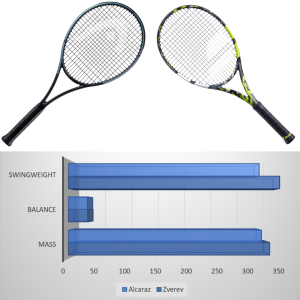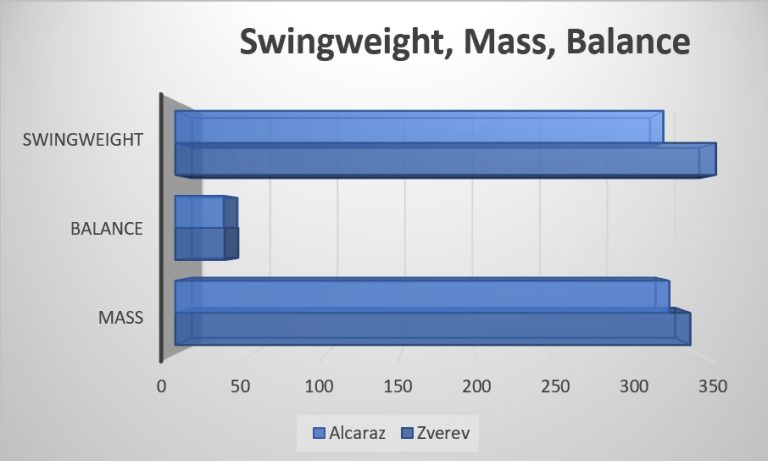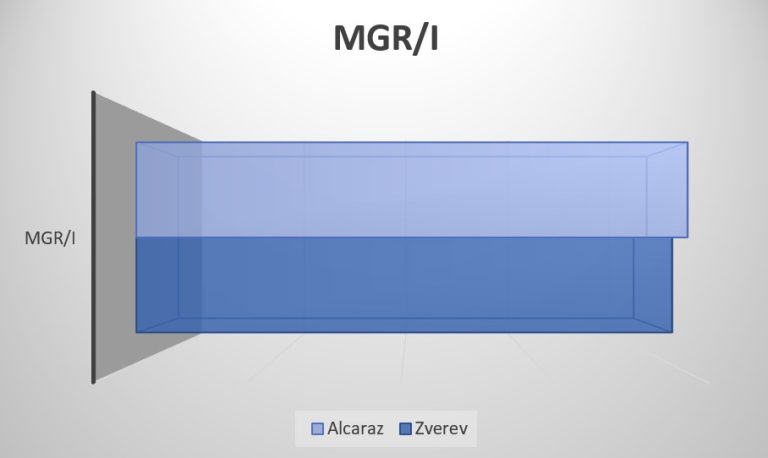
A lot of buzz surrounds the 2024 Roland Garros final, but let’s dive into the Impacting Tennis racket match-up analysis of this highly anticipated Grand Slam final. The 2024 French Open final features Carlos Alcaraz and Alexander Zverev. This intriguing match-up is not just about their skills and tactics but also about their meticulously customized rackets that significantly influence their gameplay. Alcaraz will be aiming to win his third grand slam and become the youngest player in the open era to win on all 3 surfaces. Meanwhile, Zverev is going after his first grand slam, a feat that many thought he should achieve years ago. From this perspective, Alcaraz will be more relaxed, feeling less pressure in my opinion.
As far as their strategy, rackets and games mesh up and iteract, my initial estiamtion is that it is going to come down to how much can Zverev dampen the Alcaraz game, by keeping th eball deep and heavy with his groundstrokes, like he did with Ruud in the semi-finals, where Ruud looked like he can’t hit the ball as well as he usually does. Zverev will look to do the same here, and get a weak response from Alcaraz.
But now let’s have a look at their rackets and how this translates to their game plan and interactions between them on court.
Carlos Alcaraz: Babolat Aero 98
Carlos Alcaraz, the young Spanish prodigy, wields the Babolat Aero 98, a racket known for its exceptional speed and spin capabilities. His specifications weighing in at 329 grams, with a balance point of 32.4 cm, a swingweight of 325, and an MGR/I of 20.68, this racket is engineered and his specifications tailored for aggressive baseline play and rapid shot execution. The relatively lower mass and swingweight allow Alcaraz to achieve high swing speeds. What is also worth pointing out is his big grip size L4, which many think is counterproductive with such a low weight and swingweight racket, but it smoothes out his strokes and gives him stability and control over the high Twistweight that his racket has. This is what also gives him his variety, if he want’s his racket to behave like it has a lot higher swingweight he extends his arm especially on the forehand, to achieve more body racket separation and in term has a longer lever, and effectively a higher swingweight. Both his forehand and backhand are hit further away from his body, to achieve this effect, but a bigger grip is a prerequisite for that, as it gives him control over the racket while doing that.
From a mechanical perspective, Alcaraz’s racket setup enables him to maintain aggressive rallies and dictate play with explosive groundstrokes. The Aero’s aerodynamic design facilitates quick adjustments and rapid swings, essential for his high-energy style. The higher MGR/I value of 20.68 means the racket is highly efficient in translating the player’s energy into ball speed and control, allowing Alcaraz to hit deep, heavy topspin shots consistently, while also giving him a great feel for depth. MGR/I combined with racket’s small head (effectively closer to 95 than 98), dense string pattern, 1.30 string and higher stiffness, especially in the throat give him the control and stability while swinging very fast with low weight. However, the lower swingweight requires precise timing and consistency, especially under the prolonged pressure of a Grand Slam final. Alcaraz’s ability to sustain his aggressive baseline play while maintaining precision will be critical in this match, but as mentioned MGR/I especially, helps him with this.
What is worth mentioning is that higher MGR/I, stifness and low weight also mean that the racket is not very arm friendly, which explains why Alcaraz already had a lot of arm injuries during his career and just had one recently and now playing with a right arm sleeve at the 2024 RG.
Alexander Zverev: Head Gravity Pro
On the other hand, Alexander Zverev’s choice of the Head Gravity Pro reflects his preference for stability, control, easy to use and predictable racket. With his setup, a mass of 343 grams, a balance point of 33 cm, a swingweight of 360, and an MGR/I of 20.1, Zverev’s racket is tailored for powerful serves and deep groundstrokes that are hard to attack and wear opponents down. The higher mass and swingweight provide enhanced stability and control, crucial for absorbing and redirecting Alcaraz’s aggressive shots and more importantly keep him pinned behind the baseline and make him feel like he can not use his full array of shots, because all he can do to counter Zverev’s ball is to hit hard also.
Zverev’s setup allows for consistent, powerful shot-making with minimal physical exertion, enabling him to sustain long rallies on the slow clay surface. The higher balance point aids in maintaining control with a lot of spin over his powerful strokes, ensuring deep heavy ball even during extended baseline exchanges. The lower MGR/I value of 20.1 compared to Alcaraz’s means Zverev’s racket is slightly less efficient in energy transfer, but this setup offers greater control, predictability and stability, which is essential for his powerful, groundstrokes. He doesn’t need a very high racket head speed because of the high swingweight and all he needs to do is consistently get a great contact with the ball and get a heavy ball that will smother any opponent’s game. A 100 sq. inch head size also gives him additional forgiveness on his ground strokes.


Mass, Balance, Swingweight, and MGR/I Comparison
Carlos Alcaraz:
Mass: 329
Balance: 32.4 cm
Swingweight: 325
MGR/I: 20.68
Alexander Zverev:
Mass: 343g
Balance: 33 cm
Swingweight: 360
MGR/I: 20.1
Psychological and Physical Implications
The psychological and physical dynamics will also play a crucial role in this final. Alcaraz, with his recent successes, must manage the pressure of expectations and harness his youthful exuberance into focused aggression. Zverev, driven by the pursuit of his first Grand Slam title, must navigate the mental challenges of the occasion, drawing on his experience and tactical acumen.
Expanding on the racket match-up analysis, Zverev will need to show his resolve to stick to his gameplan, because honestly, he doesn’t have a plan B if he can not trouble his opponent’s with the heavy ball, much like Nadal did in his dominant years in Roland Garros, but Nadal was able to better adapt. Alcaraz will need to try and disrupt Zverev from getting the rallies to the point where he can get his heavy strokes online, which is what Alcaraz is very good at, but I think that Zveres has the game to win if he can execute the strategy consistently. Alcaraz will need to look out for opportunities to strike when Zverev’s game dips a bit, and he can take charge. It’s going to come down to how often that happens.
Conclusion
The 2024 Roland Garros final promises a captivating battle between two of tennis’s brightest stars, showcasing the profound impact of racket customization on their gameplay. Alcaraz’s racket, designed for speed and spin, will be pitted against Zverev’s setup for control, consistency and power. This fascinating interplay of equipment and strategy will be crucial in determining the match’s outcome.
Remember, this analysis is just one piece of the puzzle; many other factors will influence the final result. However, understanding how their racket configurations shape their strategies and performance provides a deeper appreciation of the technical aspects of tennis. As we eagerly await the outcome, let’s observe how these elite players utilize their customized equipment to strive for victory on the grand stage of Roland Garros 2024.
If you would like to learn more about professional player specifications, check out our database, and if you would like to improve your racket, check our services.